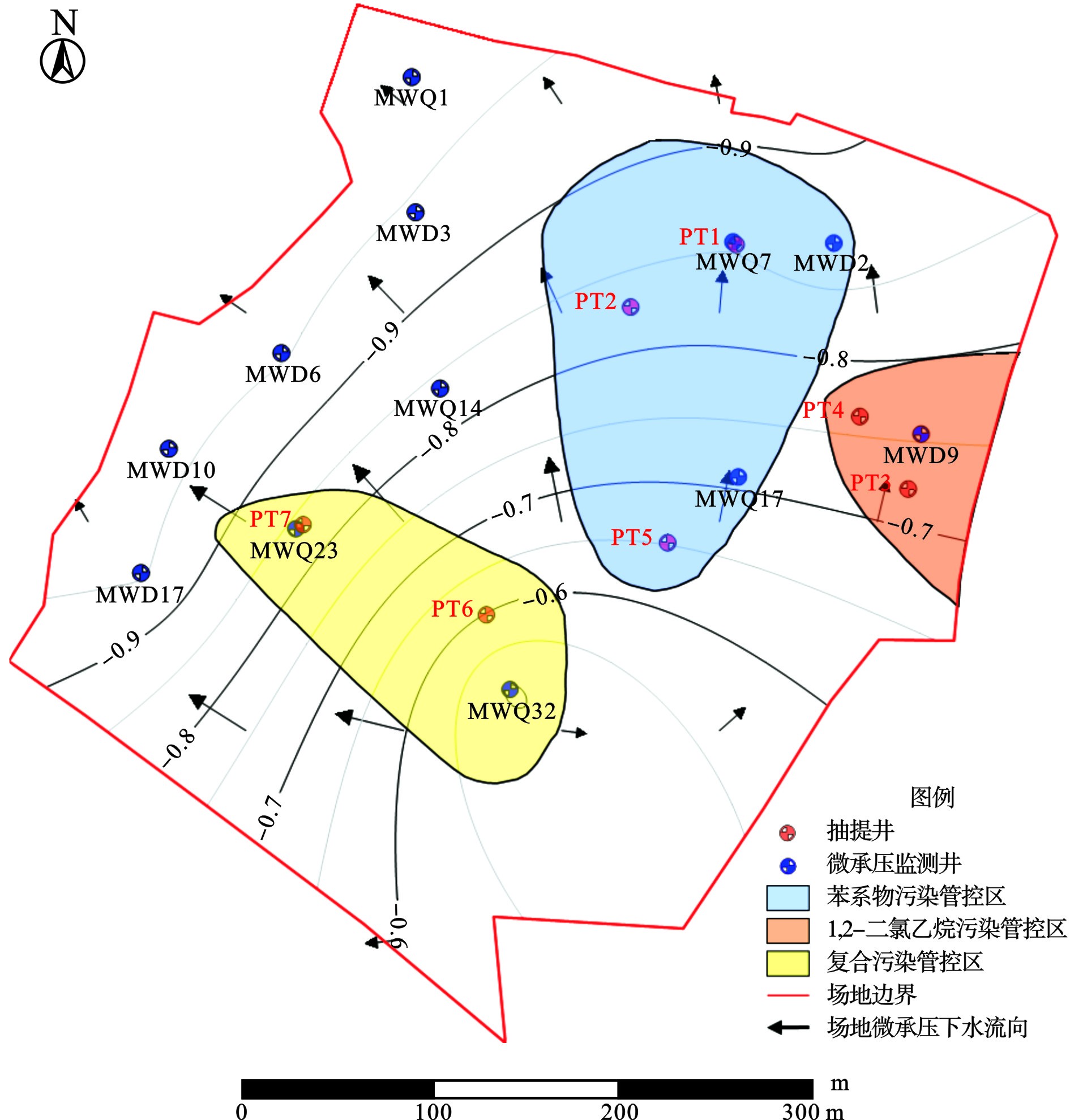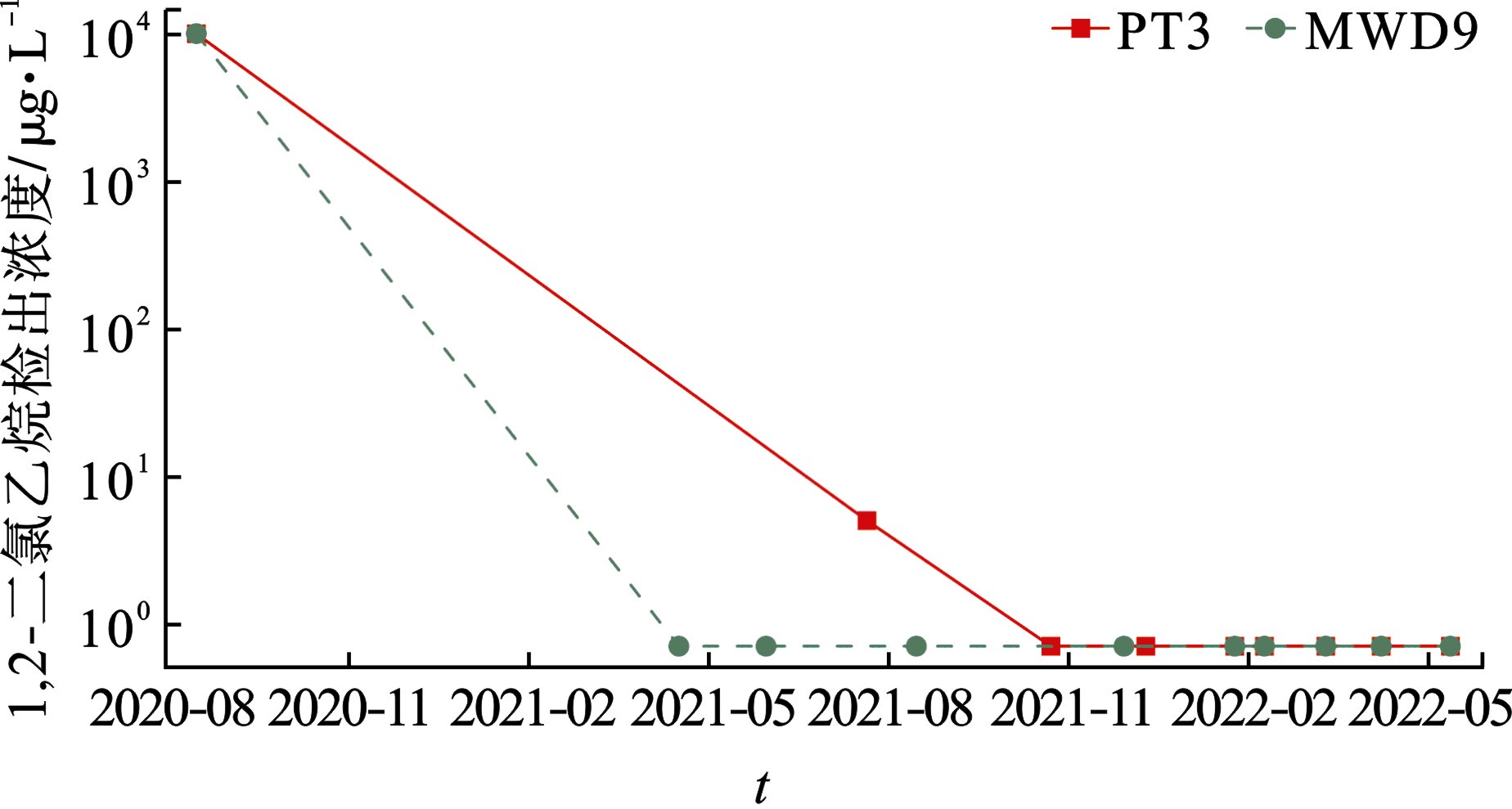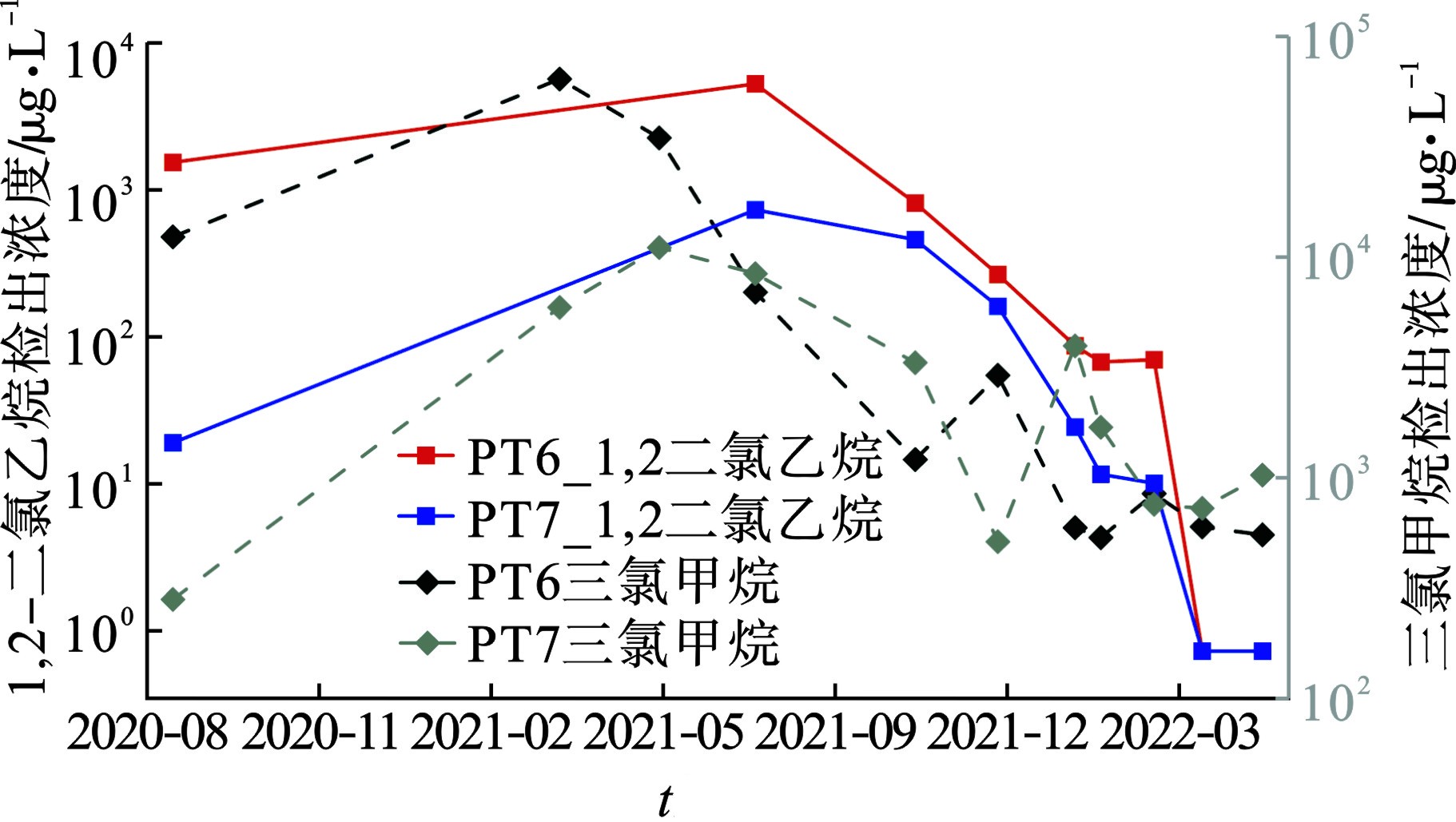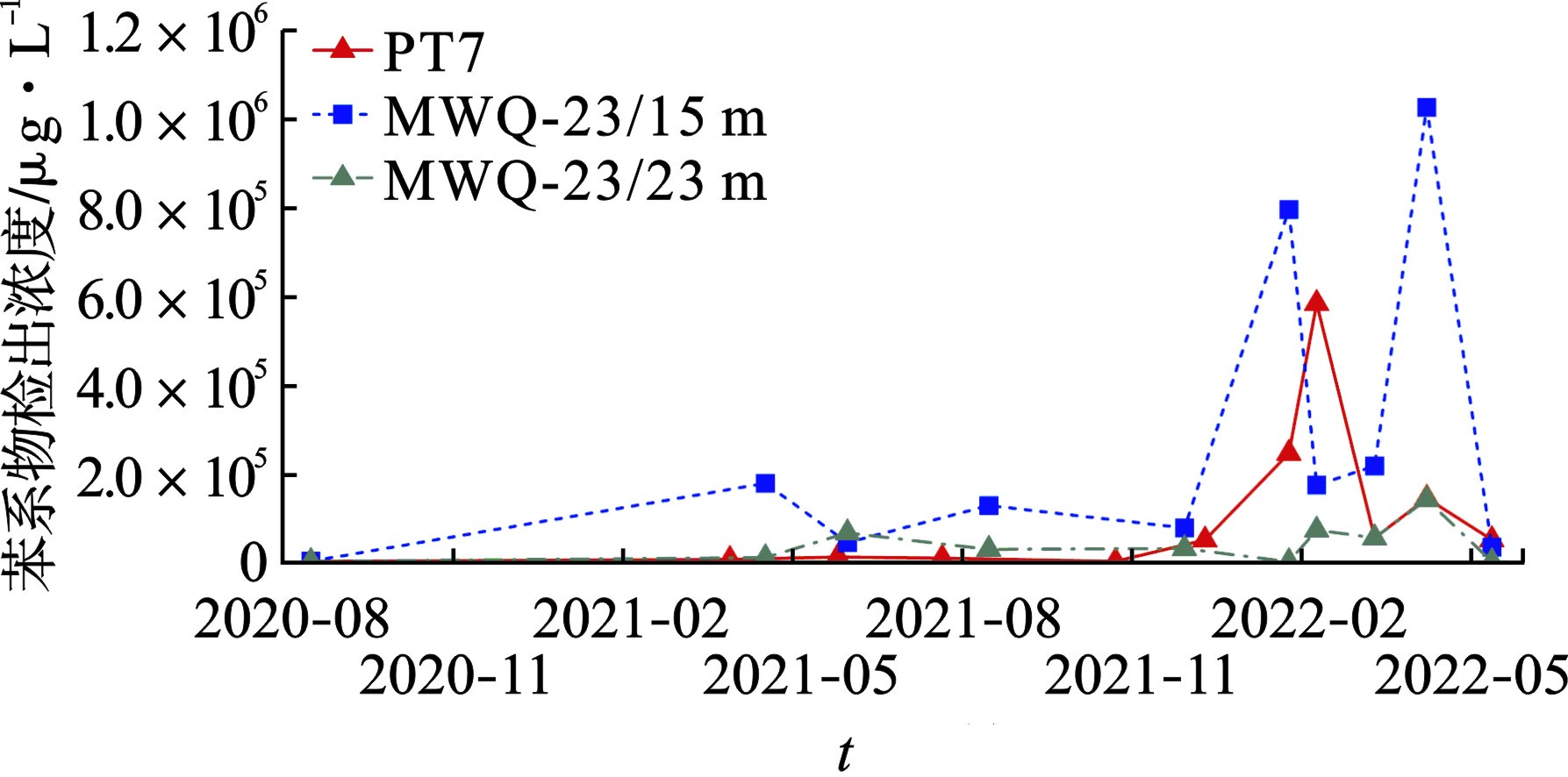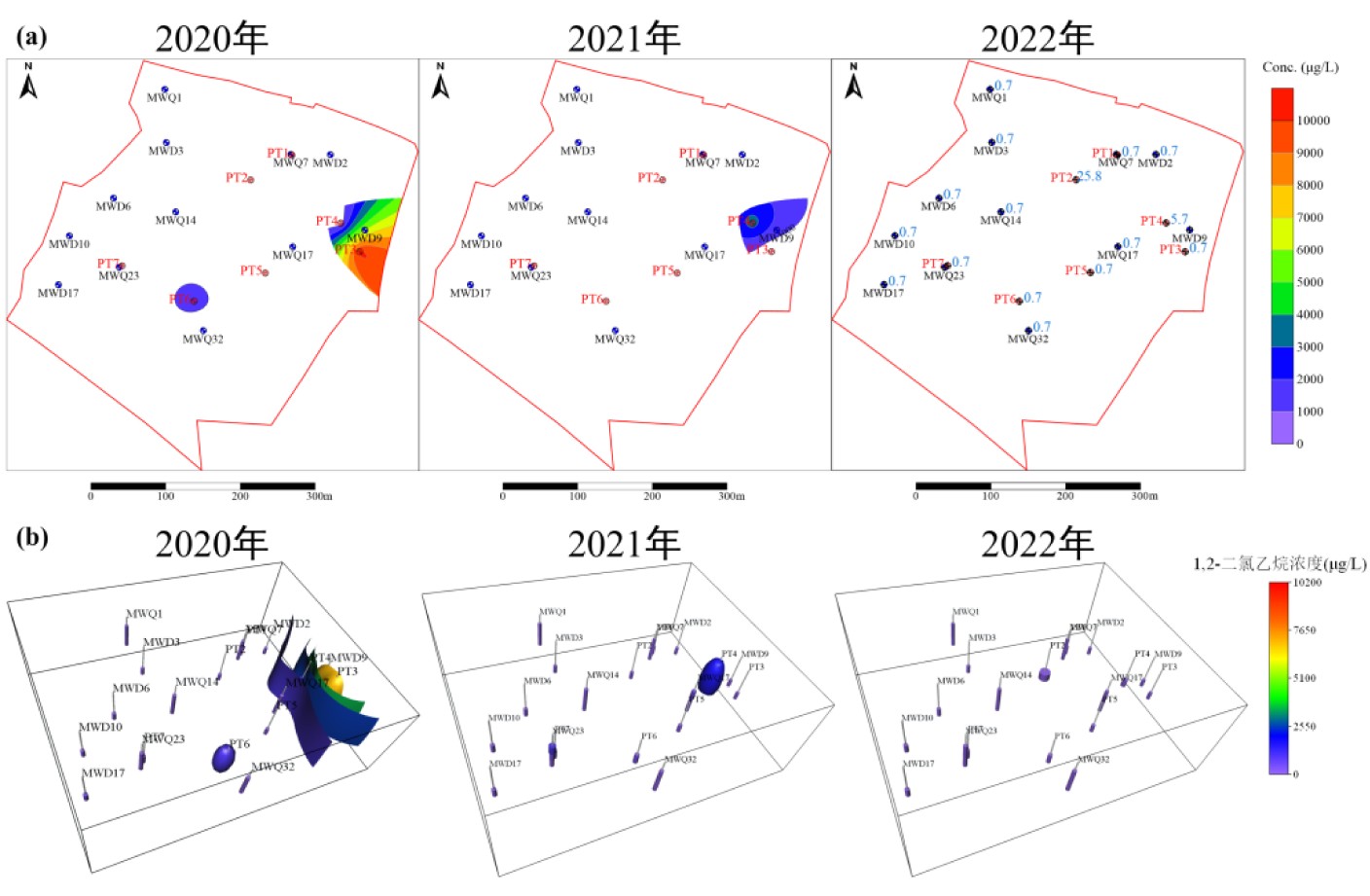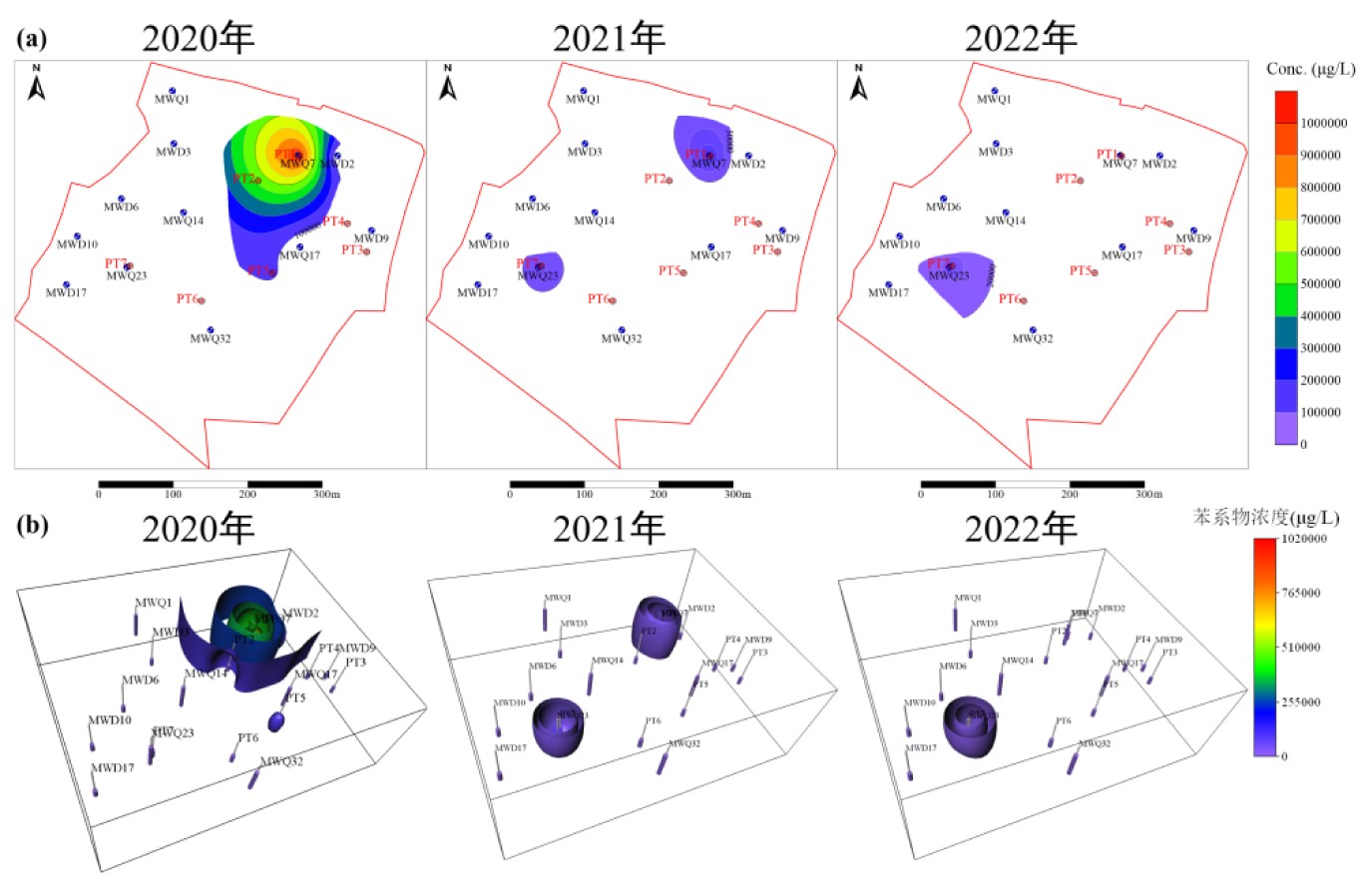-
有机物是多类行业(化工、石油加工等)的生产原料,大量有机物渗透到土壤中,会造成严重的地下水污染[1-4]。近年来,我国产业结构升级调整,造成大量工业污染场地遗留。相较于污染源去除,风险管控治理成本更低,对环境扰动更小[5],已成为污染场地地下水治理的一种经济有效的必然选择[6-8]。风险管控指综合考虑多种经济、环境、社会因素进行风险评估[9-10],采取一系列技术、工程与管理措施,将风险控制在人体和环境目标可接受范围内,以达到污染场地治理目的[11-12]。技术体系包括监测自然衰减修复,同时会结合地下水抽提处理、化学氧化、热脱附等主动修复技术。监测自然衰减主要利用污染物随地下水迁移过程中自然发生的对流弥散等物理过程,以及化学和生物(降解)作用实现污染物削减,作为一种被动修复技术,修复成本低[13-14]。主动修复技术的应用可以更好地满足场地污染控制以及时间要求等,如地下水抽出处理技术(Pump and Treat, P & T),其优点在于可以对地下水污染事件做出快速反应,能在短期内有效控制住污染羽扩散[15-16]。
自“土十条”首次提出“风险管控”的土壤污染治理原则以来,我国相继出台一系列技术导则[17-18],初步形成了污染场地风险管控制度体系。然而,对于复杂有机污染场地,土壤和地下水介质的非均质性往往导致调查结果具有不确定性,如遗漏非水相(Non-aqueous Phase Liquid, NAPL)污染源等。污染物种类复杂,多组分有机物溶解增强等效应的相互影响,以及污染物赋存形态归趋等均与场地风险密切相关[19]。复杂污染场地的风险管控工作仍有待深入研究。
本文以某典型复杂有机污染场地为例,开展风险管控工程效果评估研究。该场地污染情形复杂,存在NAPL污染风险,且地下水中存在1,2-二氯乙烷、三氯甲烷以及苯系物等多种复合污染物,代表了我国污染场地的场地条件与污染物种类多样、环境行为复杂的国情,而目前国内复杂污染场地管理仍处在初步阶段,实际应用与技术支撑较为薄弱[12,20],因此,该场地实践可以为此类典型复杂有机污染场地的风险管控体系建设提供思路。文中重点讨论风险管控实施以来,场地地下水环境质量状况的动态变化以及污染削减情况,评价风险管控效果,着重定量评估抽提处理及自然衰减对污染物总质量去除的贡献。场地风险管控体系建设、复杂多组分有机污染场地监测数据的分析过程与结果以及效果评估方法的提出,为相关复杂场地地下水污染的管控修复工作提供借鉴和指导。
-
该场地位于常州市新北区,原为农药厂和化工厂,主要生产农药原药及制剂、农药中间体、化工中间体等精细化工产品,占地面积约为18.7万m2。三十余年的生产历史造成地下水污染。根据调查结果,主要污染物是1, 2-二氯乙烷、三氯甲烷以及苯系物。
场地地势平坦,标高一般在6~8 m(吴淞基面)。场地地层结构主要分为8层,自上而下分别为:素填土、杂填土、粘土、粉质粘土、粉土、粉质砂土、粉细砂以及粉质粘土,见图1。浅层包括两个含水层,第一个含水层是潜水含水层(地下水水位埋深一般为3 m以内);第二个含水层是微承压含水层,地下水埋深一般为6 m~28 m。根据场地调查资料,受重力以及毛管压力作用影响,污染物主要集中在微承压含水层,含水层侧向连续,厚度基本不变,地下水主流向为由东南至西北,2020年8月微承压含水层等水位线图,见图2。
-
根据2020年场地调查与风险评估结果,将三种主要污染物的高浓度区域划为污染重点管控区。其中,苯系物污染管控区的苯系物最高检出浓度为1.02×106 μg/L;1,2-二氯乙烷污染管控区的1,2-二氯乙烷最高检出浓度为1.02×104 μg/L。复合污染管控区污染物种类较多,1,2-二氯乙烷、三氯甲烷和苯系物均有不同程度检出,最高检出浓度分别为1.52×103、1.23×104和656 μg/L。
基于风险评估结果采取相应风险管控措施,主要结合监测自然衰减修复以及地下水抽提技术实现污染物风险管控与修复,污染物的削减通过自然衰减以及抽提实现。监测自然衰减修复具有明显的优点,修复成本低,且能够最大程度地减少污染物在环境中的暴露和对土壤环境的扰动[21-22]。地下水抽提的优势主要在于可以直接移除地下水中的污染物[23],快速控制污染物的扩散。
-
风险管控阶段,场地地下水监测体系包含两类监测井:抽提井和微承压含水层监测井。抽提井用于抽提待处理的地下水,根据场地水文地质条件,综合考虑地下水污染管控区分布,于重点防控区内布设PT1~PT7共7口抽提井,具体布设点位如。2021年3月起持续开展7口抽提井的地下水抽提工作。2021年全年累计抽提外运处置地下水59 092 m3,2022年上半年抽提外运处置地下水18 881 m3,合计抽提地下水77 973 m3。各监测井每月的日平均抽水量,见表1。
结合场地内污染管控区分布,综合考虑场地微承压地下水主流向、污染管控区和场地边界控制效果,布设微承压含水层监测井。场地内设置6组群井(MWQ-1,MWQ-7,MWQ-14,MWQ-17,MWQ-23,MWQ-32),每组群井设置三级采样井进行地下水监测,深度分别为原始地坪以下15、23和30 m;设置6口单井(MWD2,MWD3,MWD6,MWD9,MWD10,MWD17),深度为原始地坪以下30 m。场地内共24口监测井具体布设点位,见图2。
-
2020年8月进行场地调查,2021年3月以来开展风险管控监测。监测期内,对7口抽提井,24口微承压地下水监测井进行了采样。2021年重点防控区内地下水监测井采样频次为每2个月1次,一般区域及边界控制井全年为每6个月1次;2022年,为加强风险管控监测评估,所有监测井采样频次增加至每月1次。采样工作开展时,每口监测井每次均采集送检1个地下水样品。采样过程以及样品保存均按国家标准《地块土壤和地下水中挥发性有机物采样技术导则:HJ 1019—2019》进行。
-
现场监测指标包括水温、水位、溶解氧、电导率和氧化还原电位。实验室监测指标包括pH、VOCs、SVOCs和总石油烃等以及地下水中常规无机化学组分(Fe2+/Fe3+、Cl-、NO3-、SO42-等)。
实验室指标测定时,严格按照相关技术规范与导则[24-27]控制检测过程的质量,采用标准样品、加标回收、平行样等质控手段对样品分析的准确度、精密度进行控制。关注污染因子1,2-二氯乙烷、三氯甲烷和苯系物检出限分别为1.4,1.4和5.8 μg/L。各项质控数据均符合规范要求,合格率均为100%,检测结果准确可靠。
-
污染物的总削减包括自然衰减以及抽提处理措施造成的削减两个部分。抽提处理对污染物削减的贡献率用R1(%)表示,见式(1):
式中:Ms表示污染物的总削减质量(kg);Mp表示抽提处理削减的污染物质量(kg),见式(2):
式中:V表示抽水量(m3);C表示抽出地下水中的污染物的浓度(μg/L)。
地下水中污染物总质量的计算参考Ricker所作研究,基于污染羽特征给出平面污染羽面积以及污染物平均浓度[28],进而计算微承压含水层中地下水污染物总质量Mt,见式(3):
式中:Mt表示微承压地下水中污染物总质量(kg);c表示污染物平均浓度(μg/L);s表示平面污染羽面积(m3);m表示含水层厚度(m);n为孔隙度。在计算时,给定场地微承压含水层厚度为22m,孔隙度为0.25。因此(3)式简化见式(4):
基于以上过程实现三种特征污染物总质量的计算,并由此给出污染物总质量的削减量Ms。
通过计算抽提处理对污染物削减的贡献,可由(5)式推估在场地地下水管控修复过程中,自然衰减对污染物总量削减的贡献R2 (%),见式(5):
-
基于污染管控区内地下水监测井的检测浓度数据得到污染物浓度的变化趋势,见图3和图4。
图3和图4可知,在场地风险管控阶段,苯系物污染管控区以及1,2-二氯乙烷污染管控区内主要监测井的污染物检出浓度呈现明显的削减。苯系物污染管控区PT1、PT5、MWQ-7、MWQ-17井苯系物检出浓度大幅降低(图3),苯系物管控区边界MWD2井检出浓度至2022年削减至趋向低于检出限。1,2-二氯乙烷污染管控区PT3、MWD9井1,2-二氯乙烷检出浓度同样大幅降低(图4),2021年底以来长期低于检出限。结果表明,在污染情形简单的单个污染物管控区,污染物的削减明显,地下水污染物的管控修复取得了成效。
对于污染物种类复杂的复合污染管控区,多组分有机物的增溶使得污染物的溶解行为变得复杂[29-31]。如1,2-二氯乙烷、甲苯、二甲苯等与三氯甲烷均存在互溶现象[32],在受多种组分污染的复合管控区,关注污染因子存在相互溶解增强效应,导致溶解相污染物浓度升高,使得关注污染物2021年检出浓度超过2020年初始浓度,如PT6、PT7井1,2-二氯乙烷、三氯甲烷检出浓度,见图5以及PT7、MWQ-23苯系物检出浓度,见图6。
场地风险管控监测期内,虽然1,2-二氯乙烷及三氯甲烷在增溶作用影响下,2021年污染物浓度曾超过初始情形,但2021年以来呈现明显的下降趋势(图5)。其中,1,2-二氯乙烷检出浓度至2022年4月已削减至低于检出限;2021年起,三氯甲烷检出浓度虽呈明显的下降趋势,但仍高于风险管控目标值(300 μg/L),在场地的后期处理中需持续关注。然而,苯系物检出浓度却呈现上升趋势,PT7井以及MWQ-23/15m井苯系物检出浓度的上升趋势尤为明显(图6),表明复合管控区苯系物污染风险管控效果较差。同时,结合苯系物检出浓度居高不下,并且MWQ-23/15m井的苯系物检出浓度基本远超MWQ-23/23m,说明该区苯系物污染主要集中在含水层上部,不排除该区存在轻非水相(Light Non-aqueous Phase Liquid, LNAPL)苯系物污染的可能,疑似LNAPL相源源不断溶出造成其检出浓度增大且始终处于较高范围。在后续的风险管控过程中,可结合土壤地下水取样分析进一步查明该区LNAPL污染的分布特征。
基于该场地复合污染管控区的案例分析,对于复合有机污染场地,由于污染物种类较多,不同组分间存在溶解增强等效应,以及NAPL相污染源的存在,导致污染物的污染风险与环境行为更为复杂。因此对于复杂有机污染场地,在污染调查阶段,更有赖于污染源、污染物种类及分布等的精细刻画,NAPL相污染源的遗漏等往往会增强风险管控效果的不确定性,增加管控修复的成本。
-
为呈现污染物的空间分布与变化情况,选取风险管控监测期间具有代表性的3个时间点,依次为抽提开始前(2020年)初始浓度、抽提中期(2021年底)以及抽提后期(2022年5月),绘制三种污染组分在重点管控区的平面以及垂直方向上的污染羽分布情况,见图7~图9。平面污染羽给出了风险管控区3类污染物的整体分布情况,空间污染羽显示了垂向分布特征。1,2-二氯乙烷主要集中在24~30m范围的两口抽提井PT3、PT4(图7b);三氯甲烷以及苯系物则主要集中在含水层中上部(9~25m),在含水层下部检出较少(图8b, 图9b)。年际数据定性给出了风险管控工作的实际效果。
结果显示,场地1,2-二氯乙烷以及三氯甲烷高浓度区面积以及污染物浓度均有明显削减(图7, 图8),相较于2020年初始分布,污染风险明显较低,表明风险管控取得成效。尤其对于1,2-二氯乙烷,至2022年5月,污染物检出浓度已低于风险管控目标值(40 μg/L),趋向低于检出限。对于三氯甲烷,同样显示出明显的污染物削减,最高检出浓度由12300 μg/L削减至1690 μg/L,最高检出浓度所在井位由PT6迁移至PT7(MWQ-23),这一迁移特征与场地微承压地下水流向特征相符。
苯系物污染羽分布特征变化相对比较复杂(图9),对于苯系物污染管控区,污染物削减相对明显。然而,对于复合污染管控区(主要集中在PT7/MWQ-23井),污染程度超过2020年初始情形,且该区苯系物浓度升高,结合监测井的点状分析结果,该区PT7井附近存在LNAPL相苯系物污染的风险较大,有待后续工作中进一步查明。
-
现有监测体系对污染管控区以及场地边界起到了较好的控制作用。由于地下水流向为东南到西北,主要关注西侧、北侧场界,具体为MWQ-1、MWD3、MWD6、MWD10、MWD17,2022年以来以上井位3种污染物的检出浓度均达到风险管控目标,绝大多数低于检出限,表明厂界控制效果较好。
此外,苯系物管控区边界井MWD2、MWQ-17以及复合污染管控区边界井MWQ-32也都较好地控制住了管控区边界。根据2022年污染物检出浓度数据,MWD2以及MWQ-32井的三种关注污染物的浓度均达到风险管控目标,尤其对于1,2-二氯乙烷、三氯甲烷,其浓度低于检测限,表明采取的风险管控方案有效控制了污染物的扩散。
-
对场地内三种主要污染物的削减情况进行定量,计算出风险管控实施以来,地下水抽提处理工程以及自然衰减过程对污染物削减的贡献,见表2。
结果显示,由于抽提量较小,抽提处理对场地污染物总质量削减的贡献较低,1,2-二氯乙烷、三氯甲烷、苯系物三类污染物抽提削减的比例分别为2.7%、1.8%、1.9%,自然衰减的比例均超过95%,表明自然衰减是场地内地下水中污染物削减的最主要过程。污染物通过随地下水迁移过程中自然发生的对流弥散等物理过程,以及可能发生的化学和生物(降解)作用,实现浓度以及总质量的削减。
抽提处理效果评估结果表明,监测自然衰减是实现场地地下水的风险管控的重要途径。然而,这一结论仍需进一步探讨。一方面需要结合地下水数值模拟对污染物的行为与归趋进行更准确的刻画与评估;另一方面,可结合与自然衰减过程相关的直接指标(如与微生物降解相关的中间产物、微生物群落结构等)的监测分析以做出判断。
-
本研究以常州某复杂有机污染场地为研究对象,基于污染物浓度分析,对风险管控阶段场地地下水污染物的削减情况进行了详细分析,并据此评估地下水抽提处理工程以及自然衰减过程对场地内污染物削减的贡献。
(1)管控修复工程有效控制了污染羽的扩散,对于单组分污染物管控区,污染物的削减明显,地下水污染物的管控修复取得明显成效;
(2)在复杂有机污染场地,污染物的去除主要通过自然衰减过程实现,1,2-二氯乙烷、三氯甲烷、苯系物抽提削减贡献率分别为2.7%、1.8%、1.9%。因此,在场地处理中,应持续关注自然衰减过程,联合监测自然衰减衰减进行更高效的污染物风险管控与修复[33-34]
(3)对于复合有机污染场地,污染源、污染物种类及分布的精细刻画是进行高效准确的风险管控修复工作的前提。若场地调查阶段未查明污染特征,会影响风险管控修复效果,增加管控的成本和周期。
由于本研究区污染条件复杂,监测数据有限,在后续的风险管控工作中,建议结合地下水数值模型,对污染物的行为与归趋进行更准确的刻画与评估,更好地进行抽提效果的评估;并对自然衰减过程相关的直接指标(如与微生物降解相关的中间产物、微生物群落结构等)进行相关检测分析。
复杂有机污染场地地下水风险管控工程效果评估研究
——以常州市某污染场地为例Study on the evaluation of risk management and control effect at complex organic contaminated sites ——Taking a contaminated site in Changzhou as an example
-
摘要: 以常州某典型复杂有机污染场地为例,该场地地下水中1,2-二氯乙烷、三氯甲烷以及苯系物等多种复合有机污染物严重超标。2020年经场地调查与风险评估划定了重点管控区,自2021年3月起采取地下水抽提结合自然衰减的风险管控措施。通过对管控修复工程效果进行评估,结果表明:管控修复工程有效控制了污染羽的扩散,对于单组分污染物管控区,污染物的削减明显,地下水污染物的管控修复取得明显成效;场地污染物的去除主要通过自然衰减过程实现,抽提对污染物去除的贡献较低。对于复合污染场地,在调查阶段应对污染特征进行精细刻画,以减少非水相污染源遗漏以及多组分溶解增强效应对风险管控效果的影响,制定合理有效的管控修复决策。本研究为复杂有机物污染场地风险管控体系建设与风险管控效果评估提供借鉴和科学指导。Abstract: The study takes a typical complex organic pollution site in Changzhou as an example. The groundwater in this site was poorly contaminated by 1,2-dichloroethane, trichloromethane and BTEX. The key contamination control zones were delineated in 2020 after investigation and risk assessment and the combination of groundwater pump and treatment and natural attenuation was taken from March 2021. The effect of risk management and control was assessed, the results showed that the management and control project effectively controlled the spread of the contaminant plumes, and for the single-component contaminant control area, the reduction of the contaminants was apparent, the control and restoration of groundwater contaminants achieved obvious effect; The removal of contaminants was mainly achieved through the natural attenuation processes, the contribution of pump and treat to the removal of pollutants was low; For the compound contaminated sites, the contamination characteristics should be finely characterized during the investigation stage to reduce the impact of the omission of non-aqueous phase liquid sources and the multi-component dissolution enhancement on the risk control effect, and to make reasonable remediation decisions. The results of the study have implications and guidance for the construction of risk management and control systems and the evaluation of control effects at complex contaminated sites.
-

-
表 1 各监测井平均抽水量
Table 1. Average pumping rate of each pumping well m3•d−1
t PT1 PT2 PT3 PT4 PT5 PT6 PT7 2021—03 36.8 8.2 40.9 17.7 16.9 57.3 22.5 2021—04 38.8 8.6 43.1 18.7 14.2 48.1 18.9 2021—05 46.2 10.3 51.3 22.2 8.4 28.5 11.2 2021—06 40.2 8.9 44.7 19.4 6.9 23.4 9.2 2021—07 25.2 5.6 28.0 12.1 5.8 19.7 7.7 2021—08 39.5 8.8 43.9 19.0 15.4 52.3 20.5 2021—09 39.6 8.8 44.0 19.0 16.0 54.5 21.4 2021—10 39.6 8.8 44.0 19.1 12.5 42.4 16.6 2021—11 33.6 7.5 37.4 16.2 10.9 37.0 14.5 2021—12 16.5 3.7 18.4 8.0 7.0 23.7 9.3 2022—01 21.9 4.9 24.3 3.7 4.3 14.6 5.7 2022—02 20.3 4.5 22.5 10.5 12.2 41.4 16.2 2022—03 12.6 2.8 14.0 9.8 11.3 38.3 15.0 2022—04 24.1 5.4 26.8 6.1 7.0 23.7 9.3 2022—05 25.4 5.6 28.2 11.6 13.4 45.6 17.9 表 2 污染物风险管控效果评估
Table 2. Evaluation of the effect of contamination risk management and control
污染物种类 2020年8月 2022年5月 总量削减
量/kg抽提出的地下水
污染物总质量/kg抽提削减
贡献率R1/%自然衰减
贡献率R2/%平均浓度/μg•L−1 总质量/kg 平均浓度/μg•L−1 总质量/kg 1,2-二氯乙烷 1 790.8 1 126.6 / 0.0 1 126.6 30.3 2.7 97.3 三氯甲烷 5 211.8 2 664.6 668.3 118.8 2 545.8 46.8 1.8 98.2 苯系物 203 154.7 86 839.4 6 517.0 3 653.3 83 186.1 1 610.0 1.9 98.1 -
[1] 豆捷雄, 宋瑞霞, 阮鸿洁, 等. 我国水体有机污染物前处理技术与应用的研究进展[J]. 环境与健康杂志, 2016, 33(03): 278 − 281. [2] 井柳新, 文一, 刘伟江, 等. 地下水有机污染场地地球物理方法调查探讨[J]. 环境保护科学, 2015, 41(06): 69 − 71. [3] 姚德俊, 岳昌盛, 吕建国, 等. 我国工业场地污染地下水修复技术研究进展[J]. 现代化工, 2020, 40(12): 45 − 49. [4] LI Z, SUN Y, YANG Y, et al. Biochar-supported nanoscale zero-valent iron as an efficient catalyst for organic degradation in groundwater[J]. Journal of Hazardous Materials, 2020, 383: 121240.1 − 121240.9. [5] Naidu R, Wong M H, Nathanail P. Bioavailability—the underlying basis for risk-based land management[Z]. Springer. 2015: 8775-8778. [6] Cundy A B, Bardos R P, Church A, et al. Developing principles of sustainability and stakeholder engagement for “gentle” remediation approaches: The European context[J]. Journal of Environmental Management, 2013, 129: 283 − 291. [7] 焦文涛, 方引青, 李绍华. 美国污染场地风险管控的发展历程、演变特征及启示[J]. 环境工程学报, 2021, 15(05): 1821 − 1830. [8] 龙涛. 基于风险管控的污染地块修复模式概述[J]. 环境保护科学, 2016, 42(04): 36 − 39. [9] 杨彦, 陈浩佳, 刘程成. 我国环境健康风险评估发展进程[J]. 环境与健康杂志, 2020, 37(07): 653 − 658. [10] 刘丽丽, 冯秋园, 钟名誉, 等. 典型多环芳烃污染场地土壤健康风险评估及参数敏感性分析[J]. 能源与环保, 2021, 43(12): 85 − 90. [11] Bardos R P, Bone B D, Boyle R, et al. The rationale for simple approaches for sustainability assessment and management in contaminated land practice[J]. Science of the Total Environment, 2016, 563: 755 − 768. [12] 李笑诺, 陈卫平, 吕斯丹. 国内外污染场地风险管控技术体系与模式研究进展[J]. 土壤学报, 2022, 59(01): 38 − 53. [13] US EPA. Use of monitored natural attenuation at superfund, RCRA corrective action, and underground storage tank sites[J]. United States Environmental Protection Agency, Washington, 1999. [14] Rügner H, Finkel M, Kaschl A, et al. Application of monitored natural attenuation in contaminated land management—a review and recommended approach for Europe[J]. Environmental Science & Policy, 2006, 9(6): 568 − 576. [15] 蒲敏. 污染场地地下水抽出处理技术研究[J]. 环境工程, 2017, 35(04): 6 − 10. [16] 张莉, 刘菲, 袁慧卿, 等. 地下水抽出处理技术研究进展与展望[J/OL]. 现代地质: 1-9[2023-02-28]. https://doi.org/10.19657/j.geoscience.1000-8527.2022.030. [17] 生态环境部. HJ 25.2—2019 建设用地土壤污染风险管控与修复监测技术导则[S]. 北京: 中国标准出版社, 2019. [18] 生态环境部. HJ 25.6—2019 污染地块地下水修复和风险管控技术导则[S]. 北京: 中国标准出版社, 2019. [19] 姜林, 梁竞, 钟茂生, 等. 复杂污染场地的风险管理挑战及应对[J]. 环境科学研究, 2021, 34(02): 458 − 467. [20] 常春英, 董敏刚, 邓一荣, 等. 粤港澳大湾区污染场地土壤风险管控制度体系建设与思考[J]. 环境科学, 2019, 40(12): 5570 − 5580. [21] Fan T, Yang M, Li Q, et al. A new insight into the influencing factors of natural attenuation of chlorinated hydrocarbons contaminated groundwater: A long-term field study of a retired pesticide site[J]. Journal of Hazardous Materials, 2022, 439: 129595. doi: 10.1016/j.jhazmat.2022.129595 [22] 马欣程, 徐红霞, 孙媛媛, 等. 氯代烃污染场地生物自然衰减修复研究进展[J]. 中国环境科学, 2022, 42(11): 5285 − 5298. [23] 孙军亮, 宫志强, 李璐, 等. 某氯代烃污染场地地下水抽出方案优化[J]. 环境工程, 2021, 39(11): 172 − 178. [24] 国家环境保护总局《水和废水监测分析方法》编委会. 水和废水监测分析方法[M]. 第四版. 北京. 中国环境科学出版社, 2002. [25] 环境保护部. HJ 84-2016 水质 无机阴离子(F−、Cl−、NO2−、Br−、NO3−、PO43−、SO32−、SO42−)的测定 离子色谱法[S]. 北京: 中国标准出版社, 2016. [26] 环境保护部. HJ 894-2017 水质 可萃取性石油烃(C10-C40)的测定 气相色谱法[S]. 北京: 中国标准出版社, 2017. [27] 环境保护部. HJ 639-2012水质 挥发性有机物的测定 吹扫捕集/气相色谱-质谱法[S]. 北京: 中国标准出版社, 2012. [28] Ricker J A. A practical method to evaluate ground water contaminant plume stability[J]. Groundwater Monitoring & Remediation, 2008, 28(4): 85 − 94. [29] Banerjee S. Solubility of organic mixtures in water[J]. Environmental Science & Technology, 1984, 18(8): 587 − 591. [30] Burris D R, Macintyre W G. Water solubility behavior of binary hydrocarbon mixtures[J]. Environmental Toxicology and Chemistry, 1985, 4(3): 371 − 377. doi: 10.1002/etc.5620040312 [31] 张晶, 张峰, 马烈. 多相抽提和原位化学氧化联合修复技术应用——某有机复合污染场地地下水修复工程案例[J]. 环境保护科学, 2016, 42(3): 154 − 158. [32] Green D W, Southard M Z. Perry's chemical engineers' handbook[M]. 9th ed. New York: McGraw-Hill Education, 2019. [33] US EPA. Superfund remedy report[R]. 16th ed. Washington D C: Office of Land and Emergency Management, the United States Environmental Protection Agency, 2020. [34] Kuppusamy S, Palanisami T, Megharaj M, et al. Ex-situ remediation technologies for environmental pollutants: A critical perspective[J]. Reviews of environmental contamination and toxicology, 2016, 236: 117 − 192. -



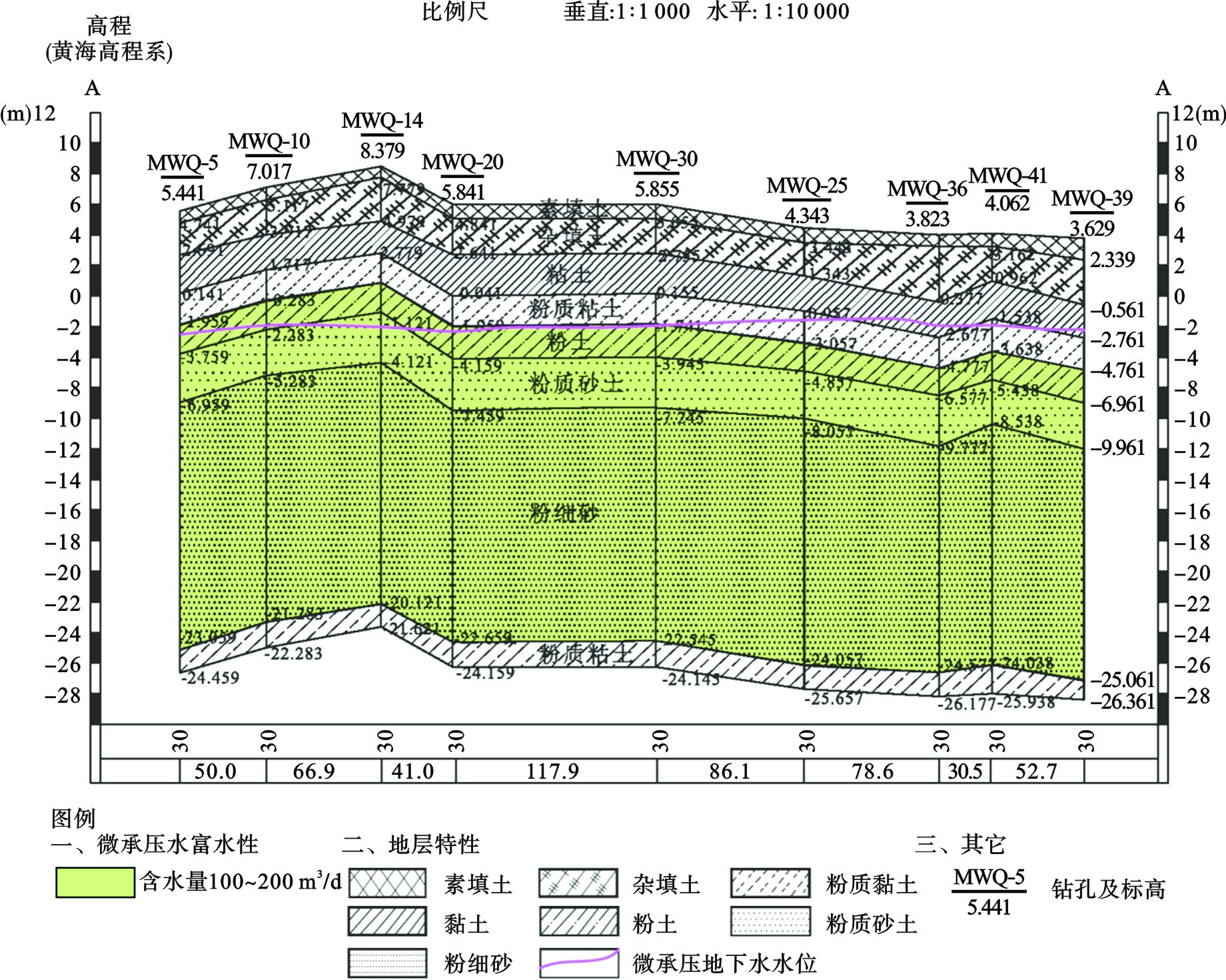
 下载:
下载:
